Developer Guide
- Introduction
- Setting up, getting started
- Design
- Implementation
- Documentation, logging, testing, configuration, dev-ops
- Appendix: Requirements
- Appendix: Instructions for manual testing
Introduction
This developer guide is meant for developers who wish to understand the internal workings of ModuleBook3.5.
Setting up, getting started
Refer to the guide Setting up and getting started.
Design
Architecture

The Architecture Diagram given above explains the high-level design of the App. Given below is a quick overview of each component.
.puml files used to create diagrams in this document can be found in the diagrams folder. Refer to the PlantUML Tutorial at se-edu/guides to learn how to create and edit diagrams.
Main has two classes called Main and MainApp. It is responsible for,
- At app launch: Initializes the components in the correct sequence, and connects them up with each other.
- At shut down: Shuts down the components and invokes cleanup methods where necessary.
Commons represents a collection of classes used by multiple other components.
The rest of the App consists of four components.
-
UI: The UI of the App. -
Logic: The command executor. -
Model: Holds the data of the App in memory. -
Storage: Reads data from, and writes data to, the hard disk.
Each of the four components,
- defines its API in an
interfacewith the same name as the Component. - exposes its functionality using a concrete
{Component Name}Managerclass (which implements the corresponding APIinterfacementioned in the previous point.
For example, the Logic component (see the class diagram given below) defines its API in the Logic.java interface and exposes its functionality using the LogicManager.java class which implements the Logic interface.

How the architecture components interact with each other
The Sequence Diagram below shows how the components interact with each other for the scenario where the user issues the command delete 1.

The sections below give more details of each component.
UI component

API :
Ui.java
The UI consists of a MainWindow that is made up of parts e.g.CommandBox, ResultDisplay, TaskListPanel, StatusBarFooter etc. All these, including the MainWindow, inherit from the abstract UiPart class.
The UI component uses JavaFx UI framework. The layout of these UI parts are defined in matching .fxml files that are in the src/main/resources/view folder. For example, the layout of the MainWindow is specified in MainWindow.fxml
The UI component,
- Executes user commands using the
Logiccomponent. - Listens for changes to
Modeldata so that the UI can be updated with the modified data.
Logic component

API :
Logic.java
-
Logicuses theModuleBookParserclass to parse the user command. - This results in a
Commandobject which is executed by theLogicManager. - The command execution can affect the
Model(e.g. adding a task). - The result of the command execution is encapsulated as a
CommandResultobject which is passed back to theUi. - In addition, the
CommandResultobject can also instruct theUito perform certain actions, such as displaying help to the user.
Given below is the Sequence Diagram for interactions within the Logic component for the execute("delete 1") API call.

Given below is the Sequence Diagram for interactions within the Logic component for the execute("mod CS2103T") API call.
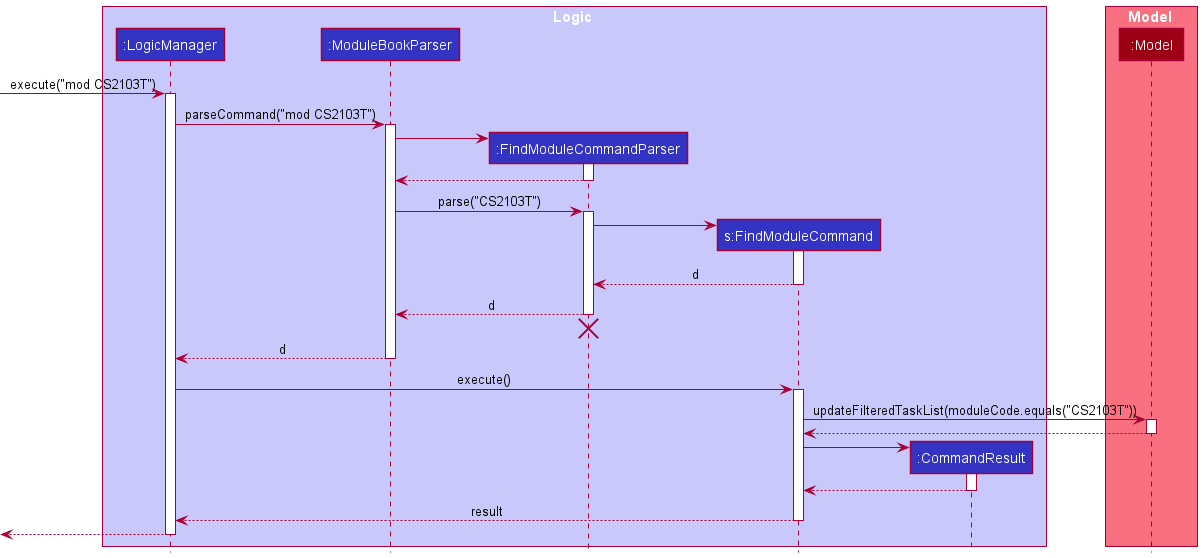
Given below is the Sequence Diagram for interactions within the Logic component for the execute("sort /w") API call.
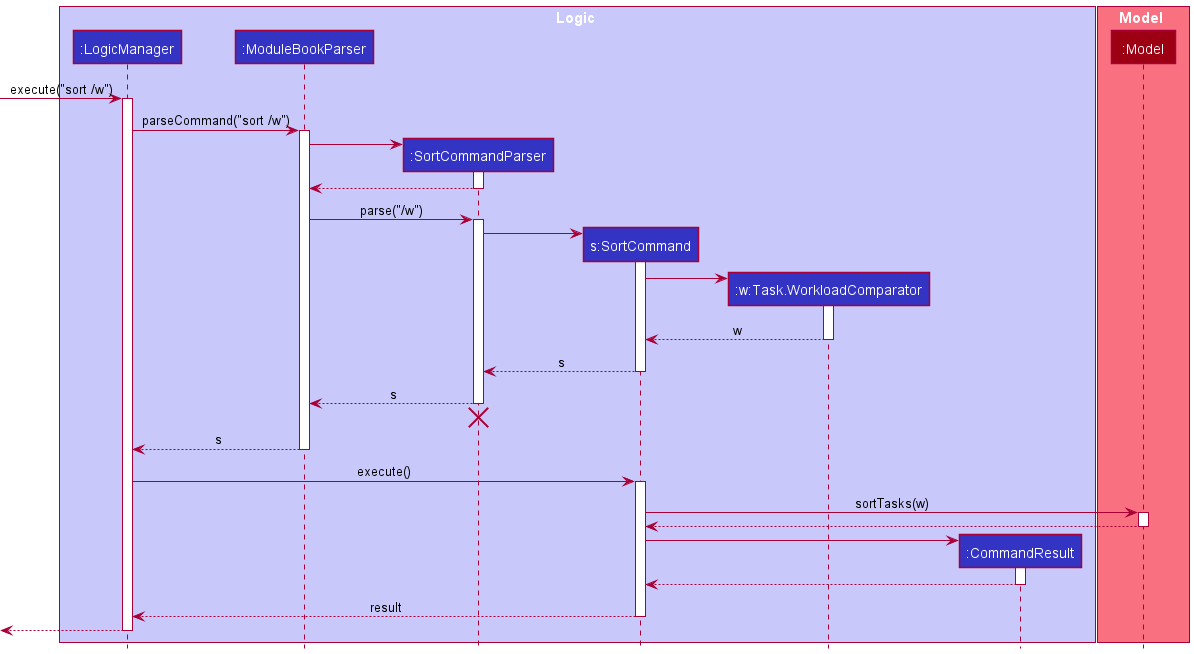
DeleteCommandParser should end at the destroy marker (X) but due to a limitation of PlantUML, the lifeline reaches the end of diagram.
Model component

API : Model.java
The Model,
- stores a
UserPrefobject that represents the user’s preferences. - stores the module book data.
- exposes an unmodifiable
ObservableList<Task>that can be ‘observed’ e.g. the UI can be bound to this list so that the UI automatically updates when the data in the list change. - does not depend on any of the other three components.
Storage component

API : Storage.java
The Storage component,
- can save
UserPrefobjects in json format and read it back. - can save the module book data in json format and read it back.
Common classes
Classes used by multiple components are in the seedu.modulebook.commons package.
Implementation
This section describes some noteworthy details on how certain features are implemented.
Done/notdone feature
Implementation
The done/notdone mechanism is facilitated by Task. It extends Task with a done status, stored internally as a DoneStatus. Additionally, it implements the following operations:
-
Task#setDoneStatus(task, doneStatus)— Creates a copy oftaskthat has newdoneStatus.
Given below is an example usage scenario and how the done mechanism behaves at each step.
Step 1. The user launches the application for the first time. The ModuleBook will be initialized with the initial module book state, and the currentStatePointer pointing to that single module book state.
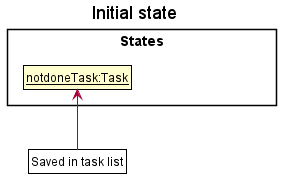
Step 2. The user executes done 5 command to mark the 5th task in the module book as done. The done command calls Task#setDoneStatus(task, doneStatus), causing the modified copy of the selected task after the done 5 command executes to be saved in the tasks list.
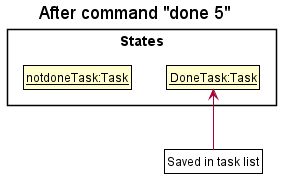
Task#setDoneStatus(task, doneStatus), so the modified copy of the task will not be saved into the tasks list.
The following sequence diagram shows how the done operation works:
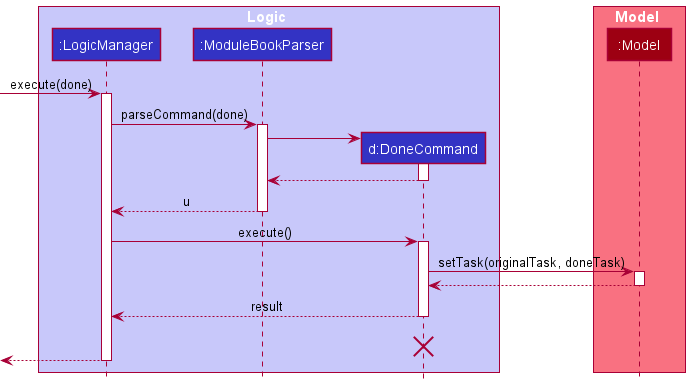
DoneCommand should end at the destroy marker (X) but due to a limitation of PlantUML, the lifeline reaches the end of diagram.
The following activity diagram summarizes what happens when a user executes done command:
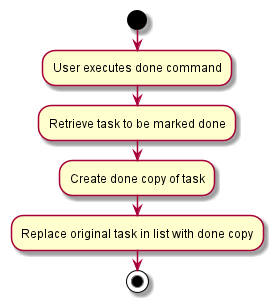
The notdone mechanism is similar to that of the done mechanism, except that the modified copy of the task is set as not done instead.
Recur feature
Implementation
The recur feature makes a task repeat at regular intervals. Internally, a Task has an attribute Recurrence that is an optional field.
Recurrence of a task can either be daily, weekly or biweekly.
Additionally, the recurrence of a task can also be removed using the recur feature.
The recurrence of a task can also be added and removed using the edit feature.
e.g. edit 1 r/daily
For a recurring task, once the recurrence to a task is added, the deadline of the task will change according to the recurrence
and the task will be marked as notdone once the task recurs.
The following activity diagram summarizes what happens upon execution of the recur feature.
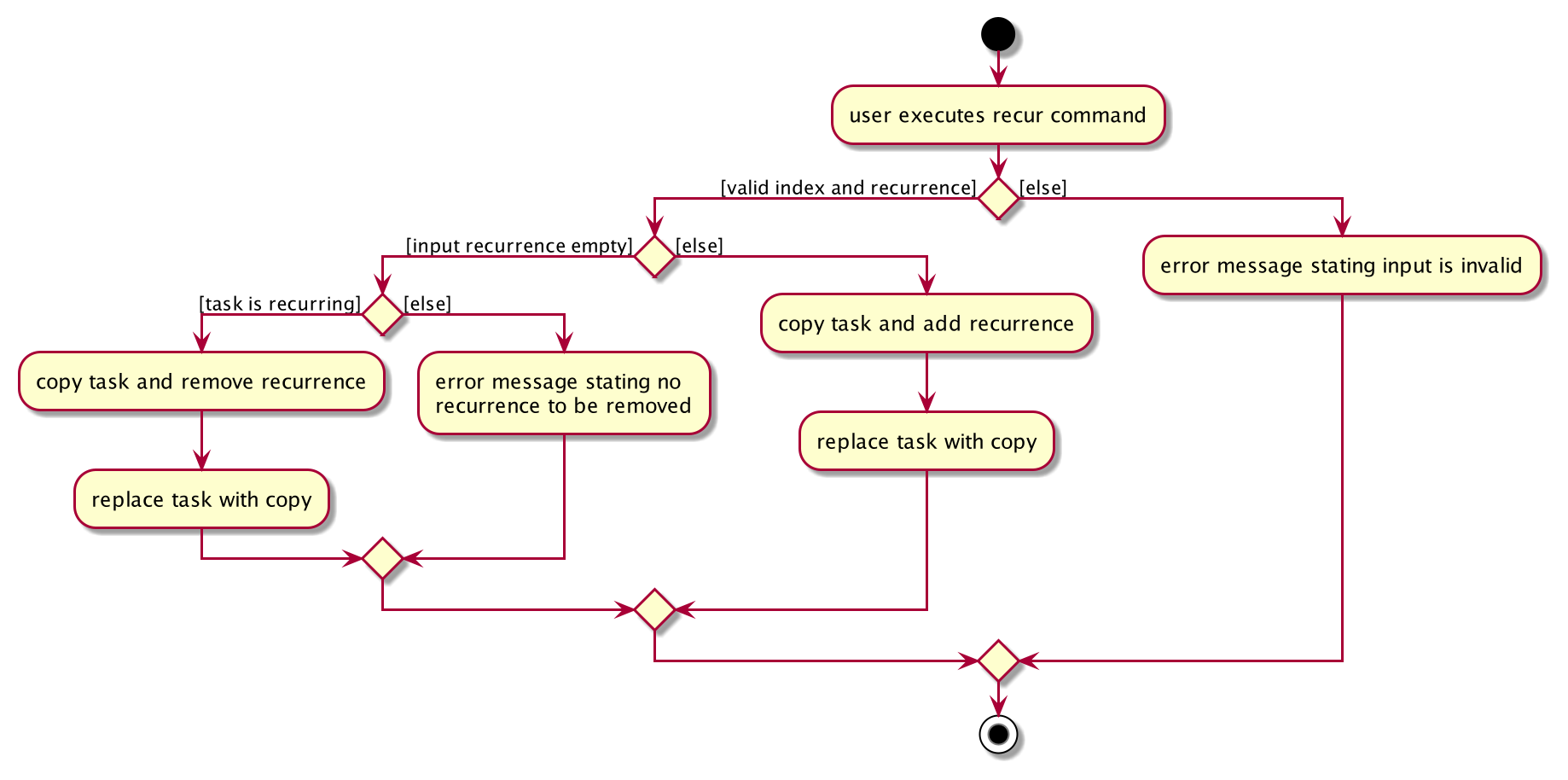
The following sequence diagram shows how the recur feature works.
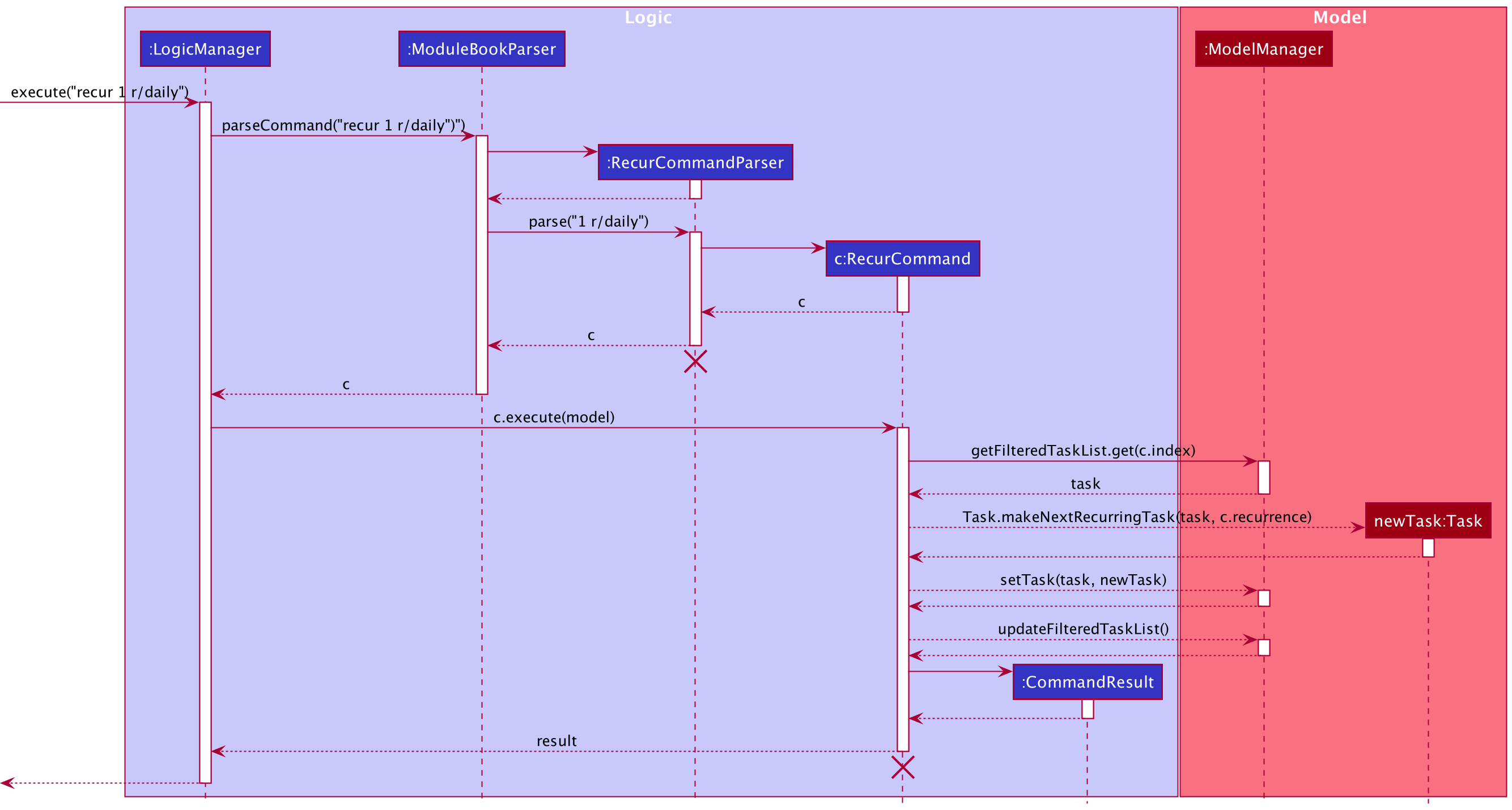
RecurCommand and RecurCommandParser should end at the destroy marker (X) but due to a limitation of PlantUML, the lifeline reaches the end of diagram.
Workload Distribution feature
Implementation
The workload distribution feature is implemented by ModuleManager. It uses HashMap and an OberservableList to monitor the workload of each module and PieChart in javaFX to visualizes it. More explicitly, it is implemented by 4 HashMaps using Module as key. The first three maps are used in the ModuleList while the map of weighted sum is used in the PieChart.
-
moduleLowWorkLoadDistribution- the value corresponds to the number of tasks with low workload. -
moduleMediumWorkLoadDistribution- the value corresponds to the number of tasks with medium workload. -
moduleHighWorkLoadDistribution- the value corresponds to the number of tasks with high workload. -
moduleWorkLoadDistribution- the value corresponds to the weighted sum of workload where low workload is counted as 1, medium workload is counted as 2, high workload is counted as 3.
It also implements following method:
-
increaseCorrectWorkloadDistribution(Module module, Task task)— Based on the workload of the task, increases the value of corresponding map and themoduleWorkloadDistribution. -
decreaseCorrectWorkloadDistribution(Module module, Task task)— Based on the workload of the task, decreases the value of corresponding map and themoduleWorkloadDistribution.
The following class diagram shows the classes related to implementing workload distribution:

«««< HEAD
=======
a39930683a3c4e47505478a14d57d4e8feb0d246
[Proposed] Undo/redo feature
Proposed Implementation
The proposed undo/redo mechanism is facilitated by VersionedModuleBook. It extends ModuleBook with an undo/redo history, stored internally as an moduleBookStateList and currentStatePointer. Additionally, it implements the following operations:
-
VersionedModuleBook#commit()— Saves the current module book state in its history. -
VersionedModuleBook#undo()— Restores the previous module book state from its history. -
VersionedModuleBook#redo()— Restores a previously undone module book state from its history.
These operations are exposed in the Model interface as Model#commitModuleBook(), Model#undoModuleBook() and Model#redoModuleBook() respectively.
Given below is an example usage scenario and how the undo/redo mechanism behaves at each step.
Step 1. The user launches the application for the first time. The VersionedModuleBook will be initialized with the initial module book state, and the currentStatePointer pointing to that single module book state.

Step 2. The user executes delete 5 command to delete the 5th task in the module book. The delete command calls Model#commitModuleBook(), causing the modified state of the module book after the delete 5 command executes to be saved in the moduleBookStateList, and the currentStatePointer is shifted to the newly inserted module book state.

Step 3. The user executes add n/David … to add a new task. The add command also calls Model#commitModuleBook(), causing another modified module book state to be saved into the moduleBookStateList.

Model#commitModuleBook(), so the module book state will not be saved into the moduleBookStateList.
Step 4. The user now decides that adding the task was a mistake, and decides to undo that action by executing the undo command. The undo command will call Model#undoModuleBook(), which will shift the currentStatePointer once to the left, pointing it to the previous module book state, and restores the module book to that state.

currentStatePointer is at index 0, pointing to the initial ModuleBook state, then there are no previous ModuleBook states to restore. The undo command uses Model#canUndoModuleBook() to check if this is the case. If so, it will return an error to the user rather
than attempting to perform the undo.
The following sequence diagram shows how the undo operation works:

UndoCommand should end at the destroy marker (X) but due to a limitation of PlantUML, the lifeline reaches the end of diagram.
The redo command does the opposite — it calls Model#redoModuleBook(), which shifts the currentStatePointer once to the right, pointing to the previously undone state, and restores the module book to that state.
currentStatePointer is at index moduleBookStateList.size() - 1, pointing to the latest module book state, then there are no undone ModuleBook states to restore. The redo command uses Model#canRedoModuleBook() to check if this is the case. If so, it will return an error to the user rather than attempting to perform the redo.
Step 5. The user then decides to execute the command list. Commands that do not modify the module book, such as list, will usually not call Model#commitModuleBook(), Model#undoModuleBook() or Model#redoModuleBook(). Thus, the moduleBookStateList remains unchanged.

Step 6. The user executes clear, which calls Model#commitModuleBook(). Since the currentStatePointer is not pointing at the end of the moduleBookStateList, all module book states after the currentStatePointer will be purged. Reason: It no longer makes sense to redo the add n/David … command. This is the behavior that most modern desktop applications follow.

The following activity diagram summarizes what happens when a user executes a new command:

Design consideration:
Aspect: How undo & redo executes
-
Alternative 1 (current choice): Saves the entire module book.
- Pros: Easy to implement.
- Cons: May have performance issues in terms of memory usage.
-
Alternative 2: Individual command knows how to undo/redo by
itself.
- Pros: Will use less memory (e.g. for
delete, just save the task being deleted). - Cons: We must ensure that the implementation of each individual command are correct.
- Pros: Will use less memory (e.g. for
{more aspects and alternatives to be added}
Documentation, logging, testing, configuration, dev-ops
Appendix: Requirements
Product scope
Target user profile:
- NUS Computer Science student
- In his/her second year of studies
- Taking tough CS modules (e.g. CS3230, CS2106, CS2103T)
- Requires organization of tasks pertaining to the modules he/she is taking
- Prefers to use the keyboard compared to a mouse
- Is reasonably comfortable using CLI apps
Value proposition: manage module related tasks faster than a typical mouse/GUI driven app
User stories
Priorities: High (must have) - * * *, Medium (nice to have) - * *, Low (unlikely to have) - *
| Priority | As a … | I want to … | So that I can… |
|---|---|---|---|
* * * |
student | add task to list | keep track of my module-related tasks and stay organized |
* * * |
student | delete a task from the list | remove the tasks I have completed or don’t want anymore |
* * |
meticulous student | mark a task as done | keep track of tasks that I have completed |
* * |
student | mark a task as undone | keep track of tasks that I’ve yet to complete or need to make edits to |
* |
meticulous student | tag tasks | filter through my tasks easily and focus on the similar ones with the same tags |
* |
user with many tasks in the module book | modify the deadline without deleting the task | waste less time recreating the whole task |
* |
user with many tasks in the module book | search for tasks by their name | find the task quickly from the large list |
* |
user with many tasks in the module book | search for tasks by module code | list down all the tasks from the same module clearly |
* |
user with many tasks in the module book | sort the tasks by deadline | see which tasks need to be addressed as soon as possible |
* |
user with many tasks in the module book | sort the tasks by workload | see which tasks require more effort to complete |
* |
busy student | view workload count for each module | decide which module requires more effort |
* |
busy student | search for tags | locate my tasks easily |
* |
busy student | delete tags | edit tags of my tasks without having to recreate them |
* |
busy student with many repeating tasks | make a task repeat daily, biweekly or weekly | avoid keying in the same task daily or weekly or biweekly |
Use cases
(For all use cases below, the System is the ModuleBook and the Actor is the user, unless specified otherwise)
Use case 01: List all tasks
MSS
-
User requests to see all tasks.
-
ModuleBook3.5 presents tasks in list form.
Extensions
- 2a. The list is empty. Use case ends.
Use case 02: Delete a task
MSS
-
User lists tasks (UC01).
-
User requests to delete a specific task in the list.
-
ModuleBook3.5 deletes the task.
-
ModuleBook3.5 updates the workload count for the relevant module.
Use case ends.
Extensions
-
2a. The list is empty.
Use case ends.
-
3a. The given index is out of range.
-
3a1. ModuleBook3.5 shows an error message.
Use case resumes at step 2.
-
Use case 03: Mark task as done
MSS
-
User lists tasks (UC01).
-
User requests to mark a task as done.
-
ModuleBook3.5 marks the task as done.
Use case ends.
Extensions
-
2a. The list is empty.
-
2a1. ModuleBook3.5 shows an error message.
Use case ends.
-
-
3a. The given index is out of range.
-
3a1. ModuleBook3.5 shows an error message.
Use case resumes at step 2.
-
-
3b. The task at given index is already done.
-
3b1. ModuleBook3.5 shows an already done message.
Use case resumes at step 2.
-
Use case 04: Mark task as not done
MSS
Same as Mark task as done (UC03), except that task is marked as not done instead of done.
Extensions
Same as extensions for Mark task as done (UC03), but with one exception:
-
3b. The task at given index is already not done.
-
3b1. ModuleBook3.5 shows a not done message.
Use case resumes at step 2.
-
Use case 05: Add a task
MSS
-
User keys in task details in the input field.
-
User request to add a task.
-
ModuleBook3.5 adds the task into the user’s list of tasks.
-
ModuleBook3.5 updates the workload count for the relevant module.
Extensions
-
2a. The exact task with the same name and module code is already present in the list.
-
2a1. ModuleBook3.5 displays an error message indicating task is present.
Use case resumes at step 2.
-
-
2b. Invalid format for the add command.
-
2b1. ModuleBook3.5 shows an error message with the correct format for add and example.
Use case resumes at step 2.
-
-
2c. The start time of the task is later than its deadline.
-
2c1. ModuleBook3.5 shows an error message.
Use case resumes at step 2.
-
Use case 06: Tag a task
MSS
-
User lists tasks (UC01).
-
User requests to add a tag to a task.
-
ModuleBook3.5 adds tag to task.
Use case ends.
Extensions
-
2a. The list is empty.
-
2b1. ModuleBook3.5 shows an error message.
Use case resumes at step 2.
-
-
2b. The given index is out of range.
-
2b1. ModuleBook3.5 shows an error message.
Use case resumes at step 2.
-
-
2c. The task at given index has the tag already.
Use case resumes at step 2.
Use case 07: Search a tag
MSS
-
User request to search for a task by inputing a tag.
-
ModuleBook3.5 find the tag and display all tasks with the tag.
Use case ends.
Extensions
-
2a. Tag not found.
-
2a1. ModuleBook3.5 shows an error message.
Use case ends.
-
Use case 08: Search a task
MSS
-
User request to search a task by inputting a name.
-
ModuleBook3.5 find the name and display all tasks with the name.
Use case ends.
Extensions
-
2a. Name not found.
-
2a1. ModuleBook3.5 shows an error message.
Use case ends.
-
Use case 09: Delete a tag
MSS
-
User lists tasks (UC01).
-
User requests to delete a specific Tag of a Task in the list.
-
ModuleBook3.5 deletes the Tag.
Use case ends.
Extensions
-
2a. The list is empty.
Use case ends.
-
3a. The given index is out of range.
-
3a1. ModuleBook3.5 shows an error message.
Use case resumes at step 2.
-
-
3b. Tag does not exist.
-
3b1. ModuleBook3.5 shows an error message.
Use case resumes at step 2.
-
Use case 10: Edit a task
MSS
-
User lists tasks (UC01).
-
User requests to edit a task’s details.
-
ModuleBook3.5 changes task details.
-
ModuleBook3.5 updates workload count for the relevant module.
Use case ends.
Extensions
-
2a. Invalid format for the edit command.
-
2a1. ModuleBook3.5 shows an error message with the correct format for edit and example.
Use case resumes at step 2.
-
-
2b. Detail to be edited is the same as original detail.
-
2b1. ModuleBook3.5 shows an error message stating that detail need not be changed.
Use case resumes at step 2.
-
-
2c. No edit inputs given.
-
2c1. ModuleBook3.5 shows an error message stating that there are no changes in the first place.
Use case resumes at step 2.
-
-
2d. The given index is out of range.
-
2d1. ModuleBook3.5 shows an error message.
Use case resumes at step 2.
-
-
2e. The start time of the edited task is later than its deadline.
-
2e1. ModuleBook3.5 shows an error message.
Use case resumes at step 2.
-
Use case 11: Search tasks by Module
MSS
-
User request to search for tasks by inputting a module code.
-
ModuleBook3.5 finds the tasks associated to the module code and display them.
Use case ends.
Extensions
-
2a. Module code not found.
-
2a1. ModuleBook3.5 shows an error message.
Use case ends.
-
Use case 12: Sorts tasks by a criterion
MSS
-
User selects a criterion request to sorts tasks.
-
ModuleBook3.5 sorts the tasks in descending order of urgency and display them.
Use case ends.
Extensions
-
2a. Invalid format for the sort command.
-
2a1. ModuleBook3.5 shows an error message with the correct format for sort and example.
Use case resumes at step 2.
-
-
2b. User selects a wrong criterion.
-
2a1. ModuleBook3.5 shows an error message with the valid criterion for sort and example.
Use case resumes at step 2.
-
Use case 13: Recur a task
MSS
-
User lists tasks (UC01).
-
User requests to recur a task.
-
ModuleBook3.5 adds recurrence to the task requested to be recurred by the user.
Use case ends.
Extensions
-
2a. The given index is out of range.
-
2a1. ModuleBook3.5 shows an error message.
Use case resumes at step 2.
-
-
2b. The recurrence is not daily, weekly or biweekly.
-
2b1. No recurrence is entered. removes recurrence (UC14)
Use case resumes at step 2.
-
-
2c. The recurrence inputted is the same as the defined recurrence of the task.
-
2c1. ModuleBook3.5 shows an error message.
Use case resumes at step 2.
-
Use case 14: Remove recurrence of a task
MSS
-
User lists tasks (UC01).
-
User requests to remove recurrence of a task.
-
ModuleBook3.5 removes recurrence of the task.
Use case ends.
Extensions
-
2a. The given index is out of range.
-
2a1. ModuleBook3.5 shows an error message.
Use case resumes at step 2.
-
-
2b. The recurrence input is not empty.
-
2b1. The recurrence input is daily, biweekly or weekly. add recurrence (UC13)
Use case resumes at step 2.
-
-
2c. The task is not recurring.
-
2c1. ModuleBook3.5 shows an error message.
Use case resumes at step 2.
-
Use case 15: Refresh all tasks
MSS
-
User requests to refresh all tasks in the list.
-
ModuleBook3.5 refreshes all tasks in the list.
Non-Functional Requirements
- Should work on any mainstream OS as long as it has Java
11or above installed. - Should work on any monitor which has a resolution greater than 1400 * 800.
- Should be able to hold up to 1000 tasks without a noticeable sluggishness in performance for typical usage.
- A user with above average typing speed for regular English text (i.e. not code, not system admin commands) should be able to accomplish most of the tasks faster using commands than using the mouse.
- The size of ModuleBook3.5 will not be larger than 20 MB.
- The project is expected to adhere to a schedule that delivers a feature set every two weeks until the end of April.
Glossary
- Mainstream OS: Windows, Linux, Unix, OS-X
- Module: A subject in NUS
Appendix: Instructions for manual testing
Given below are instructions to test the app manually.
Launch and shutdown
-
Initial launch
-
Download the jar file and copy into an empty folder
-
Double-click the jar file Expected: Shows the GUI with a set of sample contacts. The window size may not be optimum.
-
-
Saving window preferences
-
Resize the window to an optimum size. Move the window to a different location. Close the window.
-
Re-launch the app by double-clicking the jar file.
Expected: The most recent window size and location is retained.
-
Deleting a task
-
Deleting a task while all tasks are being shown
-
Prerequisites: List all tasks using the
listcommand. Multiple tasks in the list. -
Test case:
delete 1
Expected: First task is deleted from the list. Details of the deleted task shown in the status message. Timestamp in the status bar is updated. -
Test case:
delete 0
Expected: No task is deleted. Error details shown in the status message. Status bar remains the same. -
Other incorrect delete commands to try:
delete,delete x,...(where x is larger than the list size)
Expected: Similar to previous.
-
Saving data
-
Dealing with missing/corrupted data files
-
Delete
.\data\modulebook.json -
Re-launch the app by double-clicking the jar file.
Expected:.\data\modulebook.jsongenerated automatically with some example inside.
-